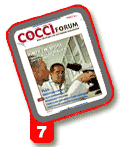COCCI ConfidentialVaccine Controls Coccidiosis, Improves Performance In Integrator's Controlled Study
Editor’s note: The information for this article was provided by a major US
poultry company on the condition that its name and location be kept
confidential. The sources mentioned in the article have nevertheless
reviewed the information for technical accuracy and approved it for
publication in CocciForum. It is presented here in our newest feature, Cocci
Confidential, to help the poultry industry learn from these real-world experiences
and improve their management of coccidiosis. If you have a story you would like
to share with Cocci Confidential, please contact the editor at [email protected]
or call 508-627-6949 (US).
The veterinarian was still skeptical.
He wanted proof that vaccinating
broilers to prevent coccidiosis
wouldn’t hurt performance. Study design
In the fall of 2002, a multi-farm, pairedhouse
trial was initiated. It involved
four, 4-house farms raising heavy broilers
(7.5 lbs). The integrator vaccinated
two houses on each farm with
Coccivac-B, a live-oocyst vaccine; in the
remaining houses, birds were fed an
anticoccidial shuttle utilizing narasin
and nicarbazin, which was the integrator’s
standard program and served as
the study’s control. Evaluations were
conducted on 156,000 birds from the
vaccinated group and on 156,000 birds
from the control group. Findings
At 4 weeks (28 days) and 7.5 weeks of
age (52 days), veterinarians from
Schering-Plough Animal Health and
Alpharma Inc. conducted posting sessions
on the 16 test houses, where they
looked for evidence of coccidialspecies. They used microscopic evaluation
for Eimeria maxima, since this
species does not always produce distinct
gross lesions and is more likely
than other Eimeria species to impair
feed conversion and weight gain. By 51
to 55 days of age, most of the lesions
received mild scores of +1 and +2
(Figures 1 and 2). The results
Vaccinated birds and the controls
receiving feed-grade anticoccidials each
demonstrated mild coccidial lesions at 4
weeks of age. However, the lesions had
resolved by the second post-mortem
exam at 7.5 weeks of age (Figures 1
and 2). Vaccination did not appear to
affect either 7-day mortality or overall
livability compared to controls. Discussion & conclusion
Coccivac delivers a controlled, balanced
dose of sporulated or infective
oocysts of the economically significant
Eimeria species. A new generation
of oocysts develop in vaccinated birds
and are then excreted, providing reexposure
to Eimeria oocysts. The
process stimulates natural, long-lasting
immunity.
Generally, it takes about two to
three oocyst cycles for strong immunity
to develop. Vaccinated birds may be
presented with a field challenge from previous flocks before their immunity is
fully established, which explains why
performance results may seem irregular
with the first cycle of Coccivac-B. |




 © 2000 - 2021. Global Ag MediaNinguna parte de este sitio puede ser reproducida sin previa autorización.
© 2000 - 2021. Global Ag MediaNinguna parte de este sitio puede ser reproducida sin previa autorización.